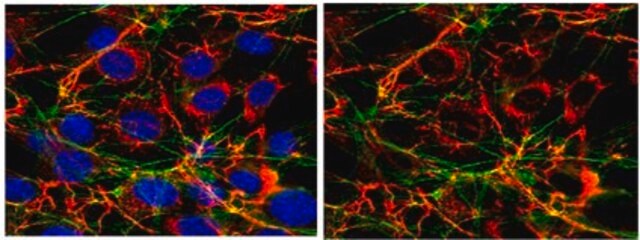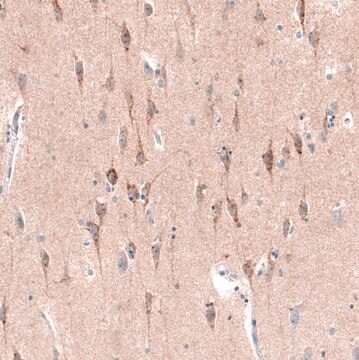一般說明
We are committed to bringing you greener alternative products, which adhere to one or more of The 12 Principles of Green Chemistry.This antibody is Preservative-free, produced without the harm or sacrifice of animals and exceptionally stable to allow for ambient shipping and storage if needed and thus aligns with "Waste Prevention", "Designing Safer Chemicals" and "Design for Energy Efficiency".
Click here for more information.
ZooMAb® antibodies represent an entirely new generation of recombinant monoclonal antibodies.
Each ZooMAb® antibody is manufactured using our proprietary recombinant expression system, purified to homogeneity, and precisely dispensed to produce robust and highly reproducible lot-to-lot consistency. Only top-performing clones are released for use by researchers. Each antibody is validated for high specificity and affinity across multiple applications, including its most commonly used application. ZooMAb® antibodies are reliably available and ready to ship when you need them.
特異性
Clone 1O16 is a ZooMAb® Rabbit recombinant monoclonal antibody that specifically detects Connective tissue growth factor (CTGF). It targets an epitope within 21 amino acids from the C-terminal region.
免疫原
KLH-conjugated linear peptide corresponding to 21 amino acids from the C-terminal region of human Connective tissue growth factor (CTGF).
應用
Quality Control Testing
Evaluated by Immunohistochemistry (Paraffin) in human kidney tissue sections.
Immunohistochemistry (Paraffin) Analysis: A 1:100 dilution of this antibody detected CTGF in human kidney tissue sections.
Tested applications
Immunohistochemistry (Paraffin) Analysis: A 1:100 dilution from a representative lot detected CTGF in human thymus tissue sections.
Affinity Binding Assay: A representative lot of this antibody bound CTGF with a KD of 4.6 x 10-8 in an affinity binding assay.
Immunocytochemistry Analysis: A 1:100 dilution from a representative lot detected CTGF in HeLa, , A431, HepG2, and NIH 3T3 cells.
Western Blotting Analysis: A 1:1,000 dilution from a representative lot detected recombinant human CTGF.
Note: Actual optimal working dilutions must be determined by end user as specimens, and experimental conditions may vary with the end user
標靶描述
CCN family member 2 (UniProt: P29279; also known as Cellular communication network factor 2, Connective tissue growth factor, Hypertrophic chondrocyte-specific protein 24, Insulin-like growth factor-binding protein 8, IBP-8, IGF-binding protein 8, IGFBP-8) is encoded by the CCN2 (also known as CTGF, HCS24, IGFBP8) gene (Gene ID: 1490) in human. CTGF is a cysteine rich extracellular matrix monomeric protein of the CCN family that is synthesized with a signal peptide (aa 1-26), which is subsequently cleaved off to produce the mature form. It is a key signaling and regulatory molecule involved in different biological processes, including cell proliferation, angiogenesis, and wound healing, and in pathological events, such as tumor development and tissue fibrosis. It also serves as a major connective tissue mitoattractant secreted by vascular endothelial cells that promotes proliferation and differentiation of chondrocytes. Its expression is also observed in bone marrow and thymic cells. Four different domains of CTGF have been described: the insulin-like growth factor binding protein (IGFBP; aa 27-98), von Willebrand factor type C repeat (VWC; aa 101-167), thrombospondin type-1 repeat (TSP1; aa 198-243), and cysteine knot-containing domain (CT; aa 256-330). IGFBP and VWC domains constitute the N-terminal half of CTGF which is separated from the C-terminal half that contains TSP1 and CT domains by a hinge region. Due to the high number of disulfide bridges, most of the CTGF domains are resistant to proteolytic digestion, and most proteases primarily cleave only in the cysteine-free hinge region, producing almost exclusively intact N- and C-terminal half fragments. The truncated CTGF domains (N-terminal fragment and C-terminal fragment), can function independently to stimulate differentiation or proliferation of fibroblast and to increase collagen synthesis. The proper expression of CTGF is essential for physiological processes in of multiple organs. CTGF knockout mice display developmental skeletal malformations, and its high expression is reported to negatively regulate myelination during development and cause a range of neurodevelopmental disorders. This ZooMAb® recombinant monoclonal antibody, generated by our propriety technology, offers significantly enhanced specificity, affinity, reproducibility, and stability over conventional monoclonals. (Ref.: Chen, Z., et al. (2020). Front. Cell Dev. Biol. 8; 593269; Tsai, CC., et al. (2018). Sci. Rep. 8; Article 7276).
外觀
Purified recombinant rabbit monoclonal antibody IgG, lyophilized in PBS with 5% Trehalose, normal appearance a coarse or translucent resin. The PBS/trehalose components in the ZooMAb formulation can have the appearance of a semi-solid (bead like gel) after lyophilization. This is a normal phenomenon. Please follow the recommended reconstitution procedure in the data sheet to dissolve the semi-solid, bead-like, gel-appearing material. The resulting antibody solution is completely stable and functional as proven by full functional testing. Contains no biocide or preservatives, such as azide, or any animal by-products. Larger pack sizes provided as multiples of 25 μL.
重構
300 μg/mL after reconstitution at 25 μL per vial. Please refer to guidance on suggested starting dilutions and/or titers per application and sample type.
儲存和穩定性
Recommend storage of lyophilized product at 2-8°C; Before reconstitution, micro-centrifuge vials briefly to spin down material to bottom of the vial; Reconstitute each vial by adding 25 μL of filtered lab grade water or PBS; Reconstituted antibodies can be stored at 2-8°C, or -20°C for long term storage. Avoid repeated freeze-thaws.
法律資訊
ZooMAb is a registered trademark of Merck KGaA, Darmstadt, Germany
免責聲明
Unless otherwise stated in our catalog or other company documentation accompanying the product(s), our products are intended for research use only and are not to be used for any other purpose, which includes but is not limited to, unauthorized commercial uses, in vitro diagnostic uses, ex vivo or in vivo therapeutic uses or any type of consumption or application to humans or animals.









